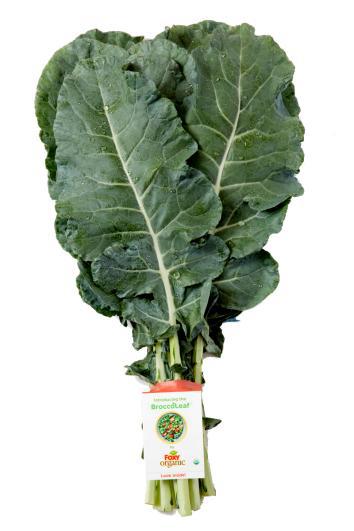Sometimes, because I am a person who writes about food on the Internet, public relations representatives offer to send me samples of new products to taste and (they hope) review. Most of the time, these product pitches concern candy, snacks, beer, or coffee. But recently, I got a pitch that was about a new vegetable—or really, an extant plant part that had recently been repackaged as a vegetable: broccoli leaves. In other words, leaves from the plant that produces broccoli.
According to its website, BroccoLeaf—the name trademarked by Foxy Produce to describe this leaf—is “a magical delicious power food veggie.” How could I resist such an appealing jumble of adjectives and nouns? I asked Foxy’s publicist to send me some.
Since the only broccoli leaves I’d ever seen were the wispy ones attached to the stalks of some heads of broccoli, I expected BroccoLeaf to look like arugula and come packaged in a sealed plastic bag, the way baby spinach does. Instead, the leaves were enormous, and came bundled up with a twist tie. (You can see how they look in the field in this video.) They resembled collard greens, except that the leaves had a curvy shape near the bottom of each stem.
For various reasons, I didn’t get a chance to cook my broccoli leaves until four days after I’d received them, and I was pleased to see that they hadn’t wilted a bit in the interim. (Hardiness is one of my top priorities when it comes to vegetables—there’s little point in buying produce that will go limp and slimy within a day or two.) As I cut the leaves away from the tough stems, I noticed that they were quite a bit softer and easier to tear than collard leaves are. They weren’t quite as lush and moist as chard, though—they seemed to fall somewhere in between those two leafy greens in texture.
This turned out to be a boon when it came to cooking: I sautéed the broccoli leaves with garlic, according to a basic recipe offered on the BroccoLeaf website, and found that they cooked much faster than collards or kale, but unlike chard or spinach, they didn’t leak tons of water as soon as they hit the hot pan. In this regard, they were the best of both worlds. Flavor-wise, they tasted pleasantly bitter—similar to broccoli rabe—and were perfectly complemented by the garlic and red pepper flakes I’d cooked them with.
Do we need another leafy green vegetable? Not really. As much as I appreciated the broccoli leaves for all the reasons outlined above, this wasn’t enough to make them inherently preferable to kale or chard. However, I would certainly buy them if they looked fresh compared to the other greens on the shelf—I have little doubt they’d be delicious in my current favorite leafy green dish, a variation on this Food52 recipe. (I use Field Roast Mexican Chipotle sausage instead of chorizo and skip the goat cheese.) It’s nice to have options.
